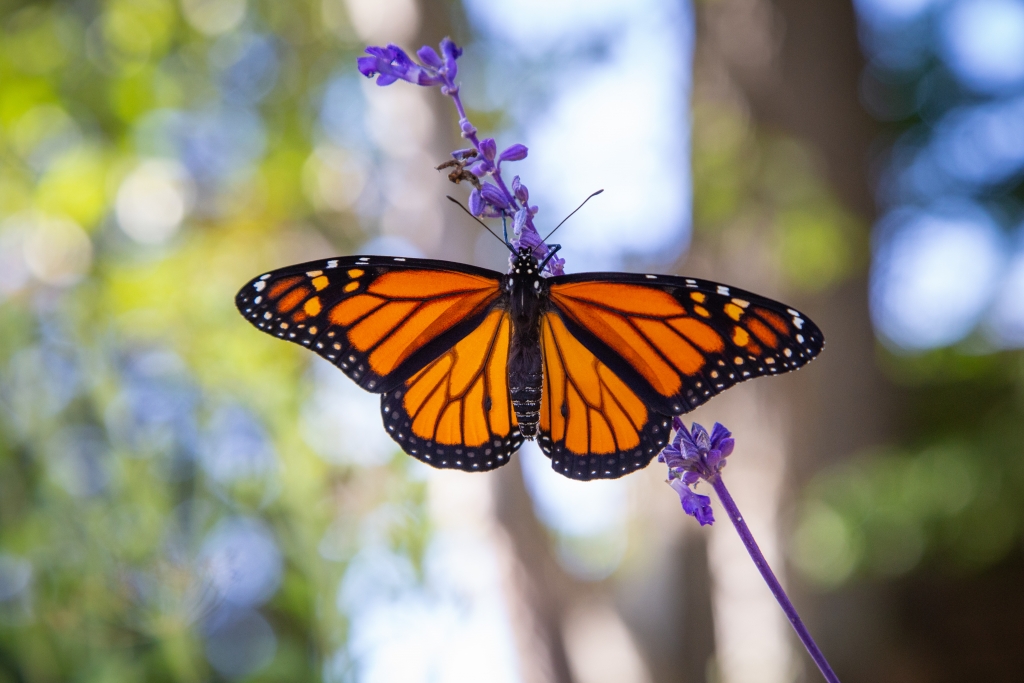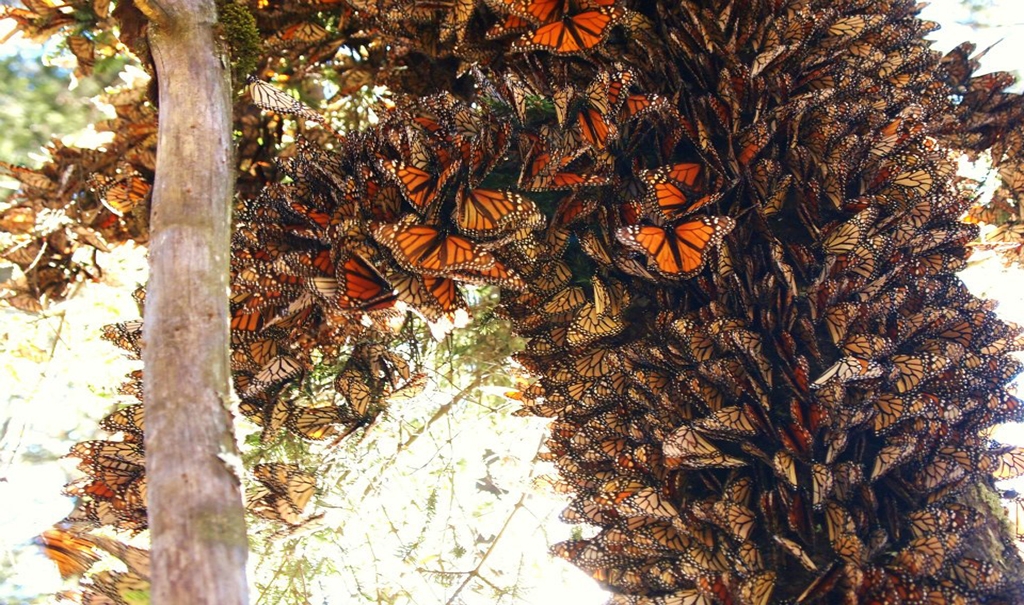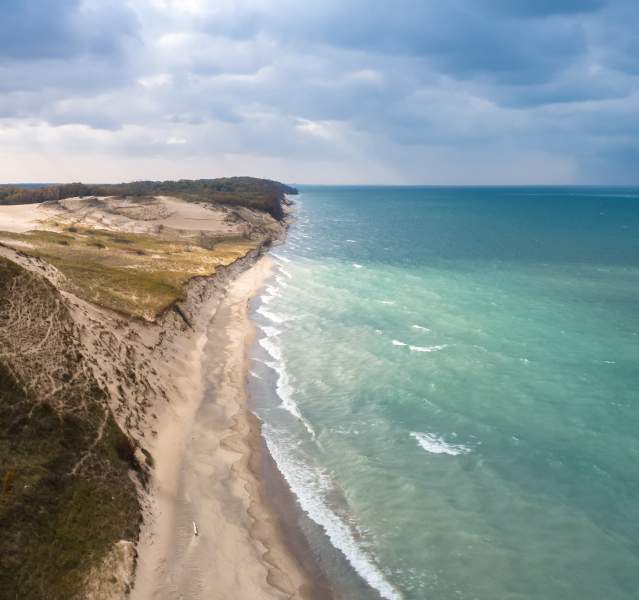Monarchs in the Indiana Dunes
by Christine Livingston
 Male monarch in my garden (C. Livingston)
Male monarch in my garden (C. Livingston)
I remember standing beneath a large cottonwood tree in the Indiana Dunes when I was a child witnessing what will likely be a once-in-my-lifetime event. The entire tree was vibrant and alive with thousands of large, brilliant, orange butterflies packed together and fluttering around near the branches. Monarchs. They were mesmerizing, and I was awestruck.
 Monarch colony (Michigan State University)
Monarch colony (Michigan State University)
These extraordinarily resilient insects have become such an inspiration to me. They are fragile, face many threats, and yet are so resilient. During their epic migration, monarchs fly further than any insect on earth. Each autumn, as if on cue, millions of monarchs begin their remarkable 2,500 (ish) - mile migration from the U.S. and Canada to a small part of the Oyamel forests in Central Mexico for the winter. They can fly up to 50 miles a day if weather and wind conditions are right because they glide on strong winds that occur at high altitudes. The trip is perilous and presents many hazards and dangers for the monarchs during their months of travel.
 Monarch being eaten by a praying mantis in the Indiana Dunes - just one of many hazards they face. (C. Livingston)
Monarch being eaten by a praying mantis in the Indiana Dunes - just one of many hazards they face. (C. Livingston)
The Mexican forest where monarchs spend their winters is endangered. Only two percent of this type of forest remain, and this small region is only about 75 miles wide. Within these forests, only a few places have the perfect conditions needed for the butterflies to survive the winter. Monarchs will congregate in specific clusters of trees with ideal temperature and humidity during the winter months to rest. Due to these rare conditions, both the Oyamel Forests in Mexico where monarchs overwinter and the open wildlands that contain milkweed and native wildflowers along the monarch’s path are critical to their survival.
In the spring, they wake, breed, and the first generation of female monarchs lead millions of butterflies north through the Midwest, Great Lakes, and Indiana Dunes areas, and far beyond. So each spring in the Indiana Dunes is ushered in with the arrival of the these small, colorful travelers.
 Monarch caterpillars on swamp milkweed in the Indiana Dunes (C. Livingston)
Monarch caterpillars on swamp milkweed in the Indiana Dunes (C. Livingston)
I’ve lived in the Indiana Dunes area my entire life. I’ve watched invasive species come, and native species decline as this area has developed. It’s inevitable–change. But I was shocked to learn recently that the brilliant orange butterflies I saw as a child by the hundred of thousands in the Indiana Dunes have declined by nearly 90 percent over the past 20 years.
 Monarch on native flowers in the Indiana Dunes (C. Livingston)
Monarch on native flowers in the Indiana Dunes (C. Livingston)
Milkweed, the monarch caterpillar's only source of food, has been steadily disappearing from our landscape. Less habitat and food translates to fewer monarchs. The U.S. Fish and Wildlife Service recently found that monarch numbers have been reduced enough that their inclusion on the endangered species list is warranted. Unfortunately, their listing is precluded by higher-priority listings.
Will monarchs go the way of the Karner Blue butterflies who were recently extirpated (when a species disappears from a specific area) from the Indiana Dunes? Surely we can do better than this.
 Common milkweed in the Indiana Dunes (C. Livingston)
Common milkweed in the Indiana Dunes (C. Livingston)
Upon learning all of this, I was moved to do something. I created a small monarch habitat in my yard. I planted several varieties of milkweed along with other native flowers, and it worked. The more milkweed and native flowers that I planted, the more monarchs came! It encouraged me to do more.
 Butterfly weed is a variety of milkweed that monarch caterpillars eat in my garden and at the Indiana Dunes Visitor Center (C. Livingston)
Butterfly weed is a variety of milkweed that monarch caterpillars eat in my garden and at the Indiana Dunes Visitor Center (C. Livingston)
My office is located at the Indiana Dunes Visitor Center, which is the gateway to the Indiana Dunes National and State Parks. The Visitor Center sits on five acres surrounded by another 15 acres of Indiana Dunes National Park property. It occurred to me that increasing native milkweed species on the Visitor Center grounds could have even more impact. So... more milkweed. And lo and behold–more monarchs at the Indiana Dunes Visitor Center, too!
 Male monarch in my garden (C. Livingston)
Male monarch in my garden (C. Livingston)
Now both my home garden and the Indiana Dunes Visitor Center are official Monarch Waystations. We are careful not to spray toxic herbicides or pesticides in either location that might harm these small, welcome travelers. Maybe monarchs and other pollinators are teaching us the consequences of so much wildland being lost to mowing, herbicides, pesticides, and development. Can we learn this lesson in time to take the actions that will help the monarch population recover? I believe we can.
 "No mow" signs and monarch at the Indiana Dunes Visitor Center (C. Livingston)
"No mow" signs and monarch at the Indiana Dunes Visitor Center (C. Livingston)
When people make conservation, a priority good things happen. Here are just a few success stories that provide me with hope:
River Otters: In the early 1900s, river otters were extirpated from most of the Midwest. Conservation efforts over the decades have been so successful that in 2005 otters were removed from Indiana’s endangered species list and have now been documented in 80 percent of Indiana counties!
Peregrine falcons and bald eagles: Both of these species were at risk of extinction/extirpation in Indiana, with only a handful of active nesting areas in the 1970s and 80s. As a result of conservation efforts, peregrines and eagles are once again nesting in hundreds of areas in Indiana and recovering across the entire Midwest! Although both populations are still closely monitored, peregrine falcons and bald eagles are now delisted as endangered species.
Deer: Believe it or not, the number of deer in Indiana was estimated at a mere 5,000 animals in 1951. In 1991, 40 years later, deer in the state numbered an estimated 350,000. Deer hunting now adds an estimated $110,000,000 annually to the state's economy.
 Monarch on a blazing star at West Beach in the Indiana Dunes (C. Livingston)
Monarch on a blazing star at West Beach in the Indiana Dunes (C. Livingston)
Back to the monarchs. It took work on behalf of many conservationists to help restore these populations of native animals. Not all stories of endangered species end well, but these success stories should encourage us. Monarch conservation is unique - and we can each protect monarchs by helping to restore their habitat! Even a pot of native milkweed on your patio can make a difference. This is a simple, affordable action that each of us can take. Every milkweed planted (and protected from pesticides and herbicides) connects monarch habitat and creates a new opportunity for a female monarch to lay her eggs.
The monarch butterfly’s short, incredible life cycle is a miracle to behold. The transformation that takes place in their short life span is worth slowing down to observe closely. It's awe-inspiring and can open each of us to the natural wonders all around us that we hurry past every day. I encourage you to explore the links I've shared to learn, observe for yourself, and get inspired to pay closer attention.

Monarch life cycle facts:
- Mom: Female monarchs carry up to 400 eggs and lay one or two pin-sized eggs on each milkweed leaf.
- Egg: The egg hatches after four days and eats its shell.
- Caterpillar: The caterpillar starts eating milkweed–only milkweed.
- Chrysalis: After two weeks the caterpillar sheds its skin and a brilliant green protective coating called a chrysalis forms.
- Butterfly: 10-12 days later, the transformation is complete. The chrysalis becomes transparent, cracks open, and the butterfly emerges.
- Flying: The butterfly pumps liquid through its veins to pump up its small, wrinkled wings. One hour after hatching, it’s ready to fly.
- Food: Adult butterflies drink nectar from a variety of flowers, including milkweed.
- Migration: It takes up to four successive generations for the monarchs to travel from Mexico to the U.S.
- Super generation: At the end of summer, the monarch third and fourth generations hatch. The final generation butterflies are larger, live six to nine months, and make the long, perilous flight south to the forests of Mexico.
- Winter: The forest protects the monarchs from abrupt temperature changes, insulating the butterflies. If trees in the forest are cut, the monarchs are left unprotected.
- Spring: The butterflies begin to warm, mate, and when the first generation hatches in Mexico, they head north and the cycle begins again.
 Monarch on a native flower in the Indiana Dunes (C. Livingston)
Monarch on a native flower in the Indiana Dunes (C. Livingston)
So what can you do? I'm sharing my monarch story in hopes that you become inspired to take your own steps to protect them. Below are 12 ideas and links to get you started:

- Butterfly garden: Create a monarch habitat in your yard. Plant milkweed and native flowers for monarchs and other pollinators.
- Waystation: Certify your monarch habitat as a monarch waystation.
- Citizen scientist: Become a citizen scientist.
- Protect the forest: Protect winter habitat in Mexico through Forest for Monarchs.
- Adopt a colony: Adopt a monarch colony. Support a butterfly sanctuary, and help nearby communities. Monarch overwintering grounds in the forests of Mexico are at risk.
- Don't use toxic chemicals: Limit your use of pesticides and herbicides in your garden.
- Share your knowledge and passion: Share what you know through educational programs, blogs, social media, and signage.
- Large habitats: If you have space, add high-quality habitat to your land.
- Walk: Walk for monarchs to raise $ through Miles for monarchs.
- Be an eco-tourist: Support Ecotourism by visiting butterfly sanctuaries that support the local economies in Mexico and provide jobs and an incentive to protect vulnerable monarch habitat.
- Join others: Join the monarch squad to provide support for World Wildlife efforts.
- More: Different people help in different ways.
Final note: What others are doing is inspiring!

